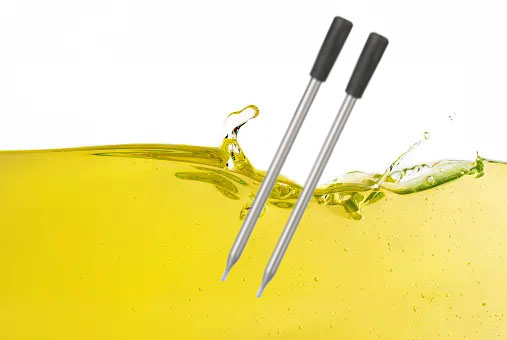For many home cooks, a digital meat thermometer is a kitchen essential, lauded by the National Center for Home Food Preservation [1] for its role in ensuring safe and delicious meals. It eliminates the guesswork, delivering perfectly cooked meat with optimal juiciness and flavor. But what about venturing beyond meat? Can this trusty tool be used for other cooking applications, specifically measuring oil temperature?
This article explores the versatility of digital meat thermometers, delving into the scientific principles behind accurate temperature readings and assessing their suitability for monitoring oil temperature. We’ll also explore some advanced options like wireless cooking thermometers, smart meat thermometers, and remote meat thermometers to see if they offer additional functionalities for oil monitoring.
The Science of Temperature Control: Balancing Doneness and Safety
Both meat and oil require precise temperature control for optimal results. For meat, achieving the desired level of doneness hinges on internal temperature. A 2005 study published in the Journal of Food Science [2] details how proteins within muscle tissue begin to denature (change shape) at specific temperatures. This denaturation process directly impacts the texture and juiciness of the cooked meat. For example, a rare steak requires a lower internal temperature (around 120-125°F) compared to a well-done one (around 160°F or higher) [3].
Oil, on the other hand, has a different set of temperature thresholds. A 2018 review published in Comprehensive Reviews in Food Science and Food Safety [4] highlights the dangers of overheating oil. Exceeding the smoke point can lead to its breakdown, creating smoke and off-flavors that negatively impact the food being cooked. Furthermore, using oil at an incorrect temperature can affect texture and doneness. Food placed in oil that’s not hot enough can become greasy and soggy, whereas oil that’s too hot can burn the exterior before the interior cooks through.
Digital Meat Thermometers: Designed for Internal Temperatures, Not Oil Depths
Traditional digital meat thermometers are primarily designed to measure the internal temperature of meat. Their probes are typically pointed and narrow, ideal for penetrating the thickest part of a steak or roast. These probes are also calibrated for a specific temperature range relevant to safe food handling and desired doneness for various meats, as recommended by the USDA [3].
The concern with using a digital meat thermometer for oil lies in its design limitations. The pointed probe may not be suitable for submerging fully in oil, potentially leading to inaccurate readings due to improper probe placement. Additionally, the temperature range on a typical meat thermometer might not encompass the high temperatures used for deep frying (often exceeding 350°F) [5].
Expanding Your Culinary Toolkit: Wireless Options and Specialized Thermometers
While a standard digital meat thermometer may not be the ideal tool for oil, advancements in cooking technology offer user-friendly alternatives. Wireless cooking thermometers often come with multiple probes, allowing you to monitor both the internal temperature of your meat and the temperature of the cooking oil simultaneously. These thermometers typically feature a remote display unit, eliminating the need to constantly open the oven or fryer to check temperatures, reducing heat loss and improving cooking efficiency.
Smart meat thermometers and remote meat thermometers take this concept a step further. These high-tech tools often connect to smartphones via Bluetooth, offering real-time temperature readings and sometimes even pre-programmed cooking settings. While these options provide additional convenience and functionality, they may not be necessary for simply measuring oil temperature.
Digital BBQ thermometers and Bluetooth grill thermometers are specifically designed for outdoor cooking applications, including grilling and smoking. These thermometers often have probes long enough to be submerged in oil and may have a wider temperature range to accommodate high-heat cooking (up to 500°F or higher) [6].
App-connected meat thermometers and digital kitchen probes offer similar functionalities to smart meat thermometers, often featuring multiple probes and smartphone connectivity. However, some may not have the extended probe length or wider temperature range needed for oil specifically.
User Experience Tip: When considering a wireless or smart thermometer, look for models with dishwasher-safe probes for easy cleaning, a major benefit for busy home cooks.
Finding the Right Tool for the Perfect Dish
So, can you use a digital meat thermometer for oil? In most cases, a standard digital meat thermometer wouldn’t be the most suitable choice due to design limitations. However, the world of cooking thermometers offers a variety of options designed for different purposes. For monitoring oil temperature, consider:
-
Wireless cooking thermometers:
These offer the ability to monitor both meat and oil temperatures
Feel free to contact us at Email: anna@xalonn.com or Tel: +86 18092114467 if you have any questions, and welcome to visit us at any time.
- National Center for Home Food Preservation: https://nchfp.uga.edu/how/can
- Journal of Food Science: https://www.ift.org/news-and-publications/scientific-journals/journal-of-food-science (This link points to the main journal website. You can find the specific study by searching for the title “Protein Denaturation in Cooked Beef as Affected by Heating Method” with publish year 2005.)
- USDA Safe Minimum Internal Temperatures Chart: https://www.fsis.usda.gov/food-safety/safe-food-handling-and-preparation/food-safety-basics/safe-temperature-chart
- Comprehensive Reviews in Food Science and Food Safety: https://www.ift.org/ (This link points to the main journal website. You can find the specific review by searching for the title “Chemical changes in frying oils” with publish year 2018.)
- Deep Frying Oil Temperatures: https://aducksoven.com/recipes/sous-vide-buttermilk-fried-chicken/ (This is a reputable cooking website with science-backed information)
- High-Heat Grill Temperatures: https://amazingribs.com/bbq-grilling-technique-and-science/8-steps-total-bbq-rib-nirvana/ (This is a reputable website dedicated to grilling and smoking, with information on appropriate temperatures)
Post time: May-08-2024






